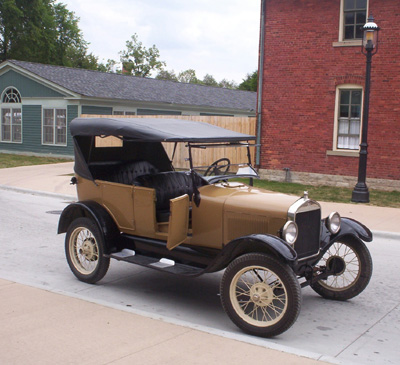Lots of us here are car nuts -- yours truly included. I had some spare time in Detroit today, so I went to
"The Henry Ford", which includes a tour of the famous
Rouge Plant.
Movie presentations of the History of Henry Ford and his legacy sparked a realization of the auto industry. His first aim was to mass-produce a car that the average person could afford to buy and operate. The Model-T was born.

I know, I'm starting to sound like a Teacher, but hear me out. Looking to our past can guide us to our future. The problem is, America forgets.

Of course, we realize that what we need is a revolutionary car today that embodies simplicity, economy, durability, and ease of maintenance. Is that possible? Adjusted for inflation, the price of the Model-T today would be less than $5000 new. You can barely buy a decent used, efficient model for that price these days.
It was a
really slow visitor day at the Dearborn Assembly Plant -- essentially I had a multi-billion-dollar facility to myself. The 2009 F-150 has been pushed back 7-8 months due to the economy and waning interest. It looked like they had stick-shift console parts for the Focus on-hand. Hmmm. Anyways, I had an interesting discussion on the way out the door.

In the lobby, a 2009 chassis and engine unit is on display. I watched a video on the new Super Duty Diesel, with twin turbos (a small, immediately responding unit, followed by a larger, higher pressure unit). Interactive info and advertising.
A representative was there to talk about the new pickup. The bus left in 20-minutes, so I thought I'd shoot the breeze.
RH77: "So this is the new F-150 chassis, eh?"
Ford Rep: "Yeah, but I'm worried that the 2015 fuel economy regulations will be impossible to meet. I mean look at it. The chassis is a box-frame, components are lightweight. How much more light and efficient can it get?
(not realizing that it was likely a scripted comment... An FE statement! OK, here we go... I took the bait, but turned it around)
"Well there's lots of things you can do."
(Meanwhile the rep gave me a "yeah right" look)
I talked about aero, gearing, ECU mapping, etc. Everything
you talk about here. After the summary, the rep was utterly shocked and about offered a job in the engineering department. If only! We talked for almost 30-minutes on what could be done. I almost missed the bus until they flagged it down.
We should all apply for automotive engineer jobs. I'll do it if you do it

Perhaps deaf ears, but it felt good to show that it's OK to "think outside the box".
The plant itself is LEED certified with a Live Vegetative roof, power saving features, and other eco-friendly features. Great-Grandson/CEO Bill Ford had to make the decision to ditch the factory or revitalize it. The location was a powerhouse since the early 1900's, establishing the first automotive assembly line, production records, and parts manufactured on-site with raw materials. The contaminated soil is also being cleansed in a natural vegetative environment.

In 1999, the family legacy lived on, at the original legendary location, and employs 6000 people (barring current layoffs). It was just shockingly silent without production. It must take a long time to turn the wheel on a big industry, to steer it in the other direction.
After the Museum visit, I headed for the airport, enlightened. If you ever have a chance to visit the campus, it's a "must see". In a bit of foreshadowing last night, I posted a pic of the Taurus wagon in the Dodge Journey thread. While GM struggled and Chrysler went bankrupt in the 80's, Ford developed a risky sedan that America grew to love. A clay scale model of that car plus a mint '86 Taurus LX and presentation was on display.

Among other transportation and Americana items, historical items were present, like: Rosa Park's bus, a gigantic C&O "Allegheny" steam locomotive, and a Dymaxion House were free to walk through). There's just too much to describe.
As I can't stress enough, let's learn from our trials of the past to forge the future. It's too easy to ignore history, yet very unwise.
RH77